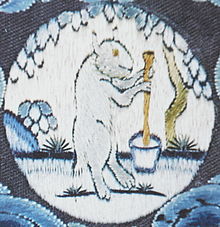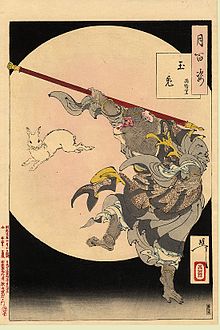Moon rabbit
| Moon rabbit | |||||||||||
|---|---|---|---|---|---|---|---|---|---|---|---|
 The image of a rabbit and mortar delineated on the Moon's surface | |||||||||||
| Chinese name | |||||||||||
| Chinese | 月兔 | ||||||||||
| Literal meaning | Moon rabbit | ||||||||||
| |||||||||||
| Alternative Chinese name | |||||||||||
| Chinese | 玉兔 | ||||||||||
| Literal meaning | Jade rabbit | ||||||||||
| |||||||||||
| Korean name | |||||||||||
| Hangul | 옥토끼 | ||||||||||
| |||||||||||
| Japanese name | |||||||||||
| Kanji | 月の兎 | ||||||||||
| |||||||||||
The moon rabbit in folklore is a rabbit that lives on the Moon, based on pareidolia that identifies the markings of the Moon as a rabbit. The story exists in many cultures, prominently in East Asian folklore and Aztec mythology.[1][2] In East Asia, it is seen pounding in a mortar and pestle, but the contents of the mortar differ among Chinese, Japanese, and Korean folklore. In Chinese folklore, it is often portrayed as a companion of the Moon goddess Chang'e, constantly pounding the elixir of life for her; but in Japanese and Korean versions, it is pounding the ingredients for rice cake.
History
An early mention that there is a rabbit on the moon appears in the Chu Ci, a Western Han anthology of Chinese poems from the Warring States period, which notes that along with a toad, there is a rabbit on the Moon who constantly pounds herbs for the immortals. This notion is supported by later texts, including the Song-era Taiping Imperial Reader. Han Dynasty poets call the rabbit on the Moon the "Jade Rabbit" (玉兔) or the "Gold Rabbit" (金兔), and these phrases were often used in place of the word for the Moon. A famous poet of Tang China, Li Bai, relates how "[t]he rabbit in the Moon pounds the medicine in vain" in his poem "The Old Dust."
Folklore


In the Buddhist Jataka tales (Tale 316),[3] a monkey, an otter, a jackal, and a rabbit resolved to practice charity on the day of the full Moon (Uposatha), believing a demonstration of great virtue would earn a great reward.
When an old man begged for food, the monkey gathered fruits from the trees and the otter collected fish, while the jackal wrongfully pilfered a lizard and a pot of milk-curd. The rabbit, who knew only how to gather grass, instead offered its own body, throwing itself into a fire the man had built. The rabbit, however, was not burnt. The old man revealed himself to be Śakra and, touched by the rabbit's virtue, drew the likeness of the rabbit on the Moon for all to see. It is said the lunar image is still draped in the smoke that rose when the rabbit cast itself into the fire.
A version of this story can be found in the Japanese anthology Konjaku Monogatarishū, where the rabbit's companions are a fox and a monkey.
Similar legends occur in Mexican folklore, where people also identified the markings on the Moon as a rabbit. According to an Aztec legend, the god Quetzalcoatl, then living on Earth as a man, started on a journey and, after walking for a long time, became hungry and tired. With no food or water around, he thought he would die. Then a rabbit grazing nearby offered herself as food to save his life. Quetzalcoatl, moved by the rabbit's noble offering, elevated her to the Moon, then lowered her back to Earth and told her, "You may be just a rabbit, but everyone will remember you; there is your image in light, for all people and for all times."
Another Mesoamerican legend tells of the brave and noble sacrifice of Nanahuatzin during the creation of the fifth sun. Humble Nanahuatzin sacrificed himself in fire to become the new sun, but the wealthy god Tecciztecatl hesitated four times before he finally set himself alight to become the Moon. Due to Tecciztecatl's cowardice, the gods felt that the Moon should not be as bright as the sun, so one of the gods threw a rabbit at his face to diminish his light. It is also said that Tecciztecatl was in the form of a rabbit when he sacrificed himself to become the Moon, casting his shadow there.
A Native American (Cree) legend tells a different variation, about a young rabbit who wished to ride the Moon. Only the crane was willing to take him. The trip stretched Crane's legs as the heavy rabbit held them tightly, leaving them elongated as cranes' legs are now. When they reached the Moon Rabbit touched Crane's head with a bleeding paw, leaving the red mark cranes wear to this day. According to the legend, on clear nights, Rabbit can still be seen riding the Moon.
Modern references
Spaceflight
- The Chinese lunar rover Yutu, which landed on the Moon on December 14, 2013, was named after the Jade Rabbit as a result of an online poll.[4]
- The Moon rabbit was mentioned in this conversation between Houston and the Apollo 11 crew just before the first Moon landing in 1969:[5]
- Houston: Among the large headlines concerning Apollo this morning, is one asking that you watch for a lovely girl with a big rabbit. An ancient legend says a beautiful Chinese girl called Chang-O has been living there for 4,000 years. It seems she was banished to the Moon because she stole the pill of immortality from her husband. You might also look for her companion, a large Chinese rabbit, who is easy to spot since he is always standing on his hind feet in the shade of a cinnamon tree. The name of the rabbit is not reported.
- Michael Collins: Okay. We'll keep a close eye out for the bunny girl.[a]
Arts
Comics and animation
- The eponymous Sailor Moon's human name is Tsukino Usagi, a pun on 月のうさぎ (Rom. Tsuki no usagi) which means Moon Rabbit in Japanese. Her daughter's name, Chibiusa means little rabbit.
- The 1998–1999 Japanese-exclusive Transformers animated series Beast Wars II features Moon, a robotic rabbit who lives in the Moon with Artemis.
- In the Dragon Ball episode "Boss Rabbit's Magic Touch", Goku exiles Monster Carrot and his henchmen to the Moon, where they are shown pounding on rice cakes.
- In Problem Children Are Coming from Another World, Aren't They?, there is a near-extinct race called the Moon Rabbits, which one of the main protagonists, Black Rabbit, belongs to.
- Kaguya Ōtsutsuki, an antagonist in Naruto, was worshipped as the Rabbit Goddess, can transform into a ten-tailed rabbit-like monster, and was sealed inside the moon by her son.
Film
- Kenneth Anger's 1972 film Rabbit's Moon takes inspiration from the folklore of the Moon rabbit.
Literature
- The Black Rabbit of Inlé from the 1972 novel Watership Down is a mythical Moon rabbit.
- Jack Hare in Masquerade is the lapine servant of the Moon (personified as a woman).
Music
- The American electronic music act Rabbit in the Moon, founded in 1991, gets its name from this legend.
- The German band Tarwater released the albums Rabbit Moon and Rabbit Moon Revisited.
- The English experimental rock band Happy Graveyard Orchestra dedicated the song The Moon Rabbit to the story.[6]
- The American folk-rock band Aztec Two-Step references the Aztec legend in their song Rabbit in the Moon.
Stage
- The rabbit in the Moon is a major theme in the 2011 musical South Street,[7] with the rabbit appearing prominently in the Moon clock in Sammy's bar, and the main character being advised to "Look to the rabbit" for inspiration.
Video games
- The 1994 scrolling shooter Fantastic Parodius – Pursue the Glory of the Past features a level in which the player traverses the Moon that is inhabited by mochi-making rabbit and hammer enemies.
- The character Reisen Udongein Inaba from the video game series Touhou Project, introduced in the 2004 game Imperishable Night, is a Moon rabbit who escaped from a war between the Moon and the Earth. In a later game in the series, Legacy of Lunatic Kingdom, released in 2015, two more Moon rabbits named Seiran and Ringo also appear.
- Yumigami, a god from the 2006 video game Ōkami, is based on the Moon rabbit folklore. It hides in the Moon's reflection and holds a mallet used for a mochi pestle.
- Chang'e and the Jade Rabbit/Moon Rabbit are featured as playable characters in the video game Smite.[8]
- One species of Moon animals in the game Disco Zoo is called Jade Rabbit.
- In the visual novel Zero Escape: Virtue's Last Reward, the AI that controls the lunar research station in which the game is set takes the form of a rabbit, in reference to this legend.
- In the 2000 Level-5 game Dark Cloud, the "Moon People" are revealed to in fact be anthropomorphic rabbits.
- In the 2D MMORPG Nexon game, Maplestory there is a party quest that involves protecting a "Moon Bunny" while it produces rice cakes.[9]
- In the 2014 FPSMMO Destiny, the Jade Rabbit is featured as both an emblem that can be acquired on the Moon, as well as a primary weapon exclusive to PlayStation 4 owners.
- The 2006 Japan-exclusive Game Boy Advance title Rhythm Tengoku includes a minigame featuring a rabbit whose goal is to hop from Earth all the way to the Moon. At the end of the game, when the rabbit is successful, an image in the Moon is seen resembling the rabbit of folklore. The game later reappears internationally in 2015's Rhythm Heaven Megamix.
See also
- Easter Bunny
- Man in the Moon
- Mid-Autumn Festival
- Mooncalf
- Rabbits and hares in art
- Rabbits in culture and literature
- Tecciztecatl
- Three hares
- Tu'er Ye
Notes
- ^ NASA transcripts had attributed the response to Aldrin (Apollo 11 Technical Air-to-Ground Voice Transcription. National Aeronautics and Space Administration. Page 179), but corrected NASA transcripts attribute it to Collins (Woods, W. David; MacTaggart, Kenneth D.; O'Brien, Frank. "Day 5: Preparations for Landing". The Apollo 11 Flight Journal. National Aeronautics and Space Administration. Retrieved 12 October 2014).
References
- ^ "The Great Hare". webtv.net.
- ^ Windling, Terri. The Symbolism of Rabbits and Hares.
- ^ Source: [1] (accessed: Saturday January 23, 2010)
- ^ Ramzy, Austin. "China to Send 'Jade Rabbit' Rover to the Moon". nytimes.com.
- ^ Woods, W. David; MacTaggart, Kenneth D.; O'Brien, Frank. "Day 5: Preparations for Landing". The Apollo 11 Flight Journal. National Aeronautics and Space Administration. Retrieved 12 October 2014
- ^ "The Moon Rabbit, by Happy Graveyard Orchestra". bandcamp.com.
- ^ "Theater review: 'South Street' at the Pasadena Playhouse". LA Times. 2011-09-28. Retrieved 2012-07-28.
- ^ Chang'e dances into Smite, brings Jade Rabbit with her.
- ^ "Moon Bunny's Rice Cake Party Quest – MapleStory – HS.MapleGlobal". hidden-street.net.
External links
- Kazumaro, Kanbe. "Buddhist sayings in everyday life – Tsuki no Usagi". Otani University. 2005. Retrieved on July 25, 2007.Template:Ja icon
- Varma. C.B. "The Hare on the Moon". The Illustrated Jataka & Other Stories of the Buddha. 2002. Retrieved on July 25, 2007.
- 「與月為伴 愉閱中秋」, Taipei Public Library. 2006. Retrieved on July 25, 2007. Template:Zh icon
- Wood, Douglas – "Rabbit and the Moon"

